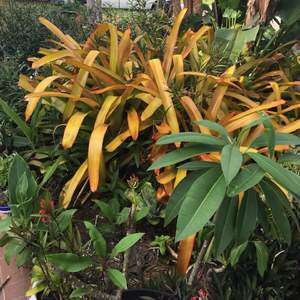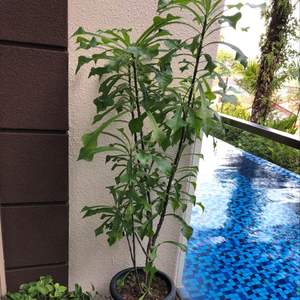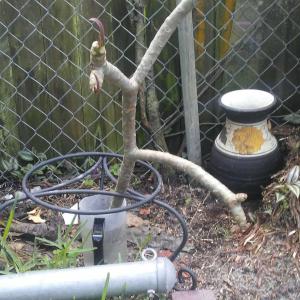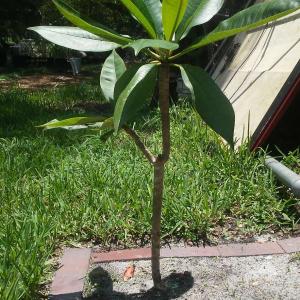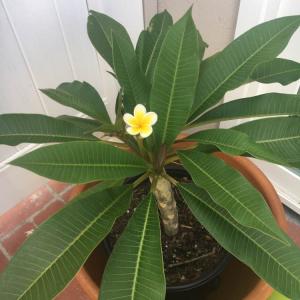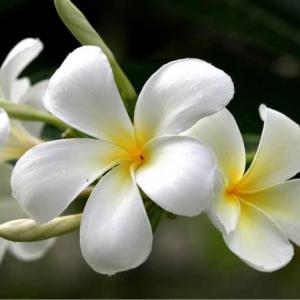文章
Miss Chen
2018年07月29日

If you enjoy growing tropical plants with colorful flowers, the plumeria plant (Plumeris spp.) could be an excellent choice for your garden or as a small indoor tree. Also called the frangipani or temple tree, the plant grows outdoors year-round in U.S. Department of Agriculture plant hardiness zones 9 through 11. You can help keep a plumeria tree in good shape and promote plenty of flowers by pruning it regularly.

The Best Method
A plumeria tree is naturally short and stocky, developing a broad crown and reaching 12 feet or more when it's 6 years old, although this can vary with the variety. Some species, such as West Indian Jasmine (Plumeria alba), which grows in USDA zones 10 through 12, can grow 40 feet tall a if left unpruned. When cutting back a plumeria, use a sharp knife or pruning shears. For a tall plumeria, you might need a pruning saw mounted on a tall pole. Always make cuts at an angle so water won't collect in the cut end of the branch and encourage fungal disease. It's also important to prevent spread of diseases by disinfecting your pruning blades after each cut, wiping them well with rubbing alcohol or dipping them in a container of rubbing alcohol.
Timing
You can prune a plumeria tree at any time, but pruning an actively growing tree can leave unsightly branch stubs until new growth starts. The plant slows its growth in winter, dropping its leaves and looking bare until new ones appear in spring. During this dormant season, it's easy to see the tree's basic form, making pruning decisions easier. To allow the tree to set blossoms for the following season, prune lightly so that enough young growth remains to produce new flowers in spring. To keep the tree within bounds, you can repeat light winter pruning every year or two until the tree reaches a suitable size for its location.
The Overall Plan
If your plumeria is just few years old, you can help control its size in future years by heading it back every year or two, cutting healthy branches back by about one-third. This also encourages lots of new branches that help fill in the tree's shape as it grows and eventually produce flower buds. An older tree that's outgrown its space may respond well to a method called pollarding, which involves removing the upper branches from a mature tree to promote a dense canopy of foliage. This method reduces the tree's size and can keep a mature tree at a predetermined height. Regardless of the tree's age, how often you prune depends somewhat on the tree's response. If there's abundant new growth the following year, you can prune yearly, but if growth appears slowly, it's a good idea to skip a year or two between prunings.

After Pruning
You can help stimulate a newly pruned plumeria to put out healthy growth by fertilizing it regularly during its growing season. Use a granular, 10-30-10 formula, applied at the rate of 1 pound per 1 inch of trunk diameter. Spread the fertilizer under the tree evenly, scratching it into the soil and distributing it to about 2 feet beyond its drip line, which is the outermost area where foliage extends over the ground. Providing adequate water also supports new growth, especially during summer dry spells -- supply enough water to keep the soil moist but not soggy, generally about 1/2 to 1 inch weekly.

The Best Method
A plumeria tree is naturally short and stocky, developing a broad crown and reaching 12 feet or more when it's 6 years old, although this can vary with the variety. Some species, such as West Indian Jasmine (Plumeria alba), which grows in USDA zones 10 through 12, can grow 40 feet tall a if left unpruned. When cutting back a plumeria, use a sharp knife or pruning shears. For a tall plumeria, you might need a pruning saw mounted on a tall pole. Always make cuts at an angle so water won't collect in the cut end of the branch and encourage fungal disease. It's also important to prevent spread of diseases by disinfecting your pruning blades after each cut, wiping them well with rubbing alcohol or dipping them in a container of rubbing alcohol.
Timing
You can prune a plumeria tree at any time, but pruning an actively growing tree can leave unsightly branch stubs until new growth starts. The plant slows its growth in winter, dropping its leaves and looking bare until new ones appear in spring. During this dormant season, it's easy to see the tree's basic form, making pruning decisions easier. To allow the tree to set blossoms for the following season, prune lightly so that enough young growth remains to produce new flowers in spring. To keep the tree within bounds, you can repeat light winter pruning every year or two until the tree reaches a suitable size for its location.
The Overall Plan
If your plumeria is just few years old, you can help control its size in future years by heading it back every year or two, cutting healthy branches back by about one-third. This also encourages lots of new branches that help fill in the tree's shape as it grows and eventually produce flower buds. An older tree that's outgrown its space may respond well to a method called pollarding, which involves removing the upper branches from a mature tree to promote a dense canopy of foliage. This method reduces the tree's size and can keep a mature tree at a predetermined height. Regardless of the tree's age, how often you prune depends somewhat on the tree's response. If there's abundant new growth the following year, you can prune yearly, but if growth appears slowly, it's a good idea to skip a year or two between prunings.

After Pruning
You can help stimulate a newly pruned plumeria to put out healthy growth by fertilizing it regularly during its growing season. Use a granular, 10-30-10 formula, applied at the rate of 1 pound per 1 inch of trunk diameter. Spread the fertilizer under the tree evenly, scratching it into the soil and distributing it to about 2 feet beyond its drip line, which is the outermost area where foliage extends over the ground. Providing adequate water also supports new growth, especially during summer dry spells -- supply enough water to keep the soil moist but not soggy, generally about 1/2 to 1 inch weekly.
0
0
文章
Dummer. ゛☀
2017年09月30日

Plumeria plants, which are also known as Lei Flowers and Frangipani, are actually small trees that are native to tropical regions. The flowers of these beautiful plants are used in making traditional Hawaiian leis. They are highly fragrant and bloom freely from spring throughout fall in multiple colors like white, yellow, pink, and red. These flowers stand out nicely amid the large-leaved foliage, which may be evergreen or deciduous, depending on the type.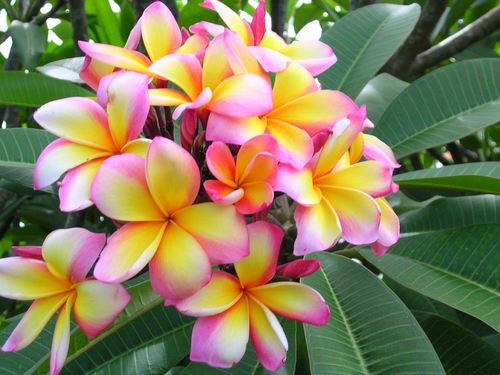
Although you don’t have to live in the tropics to grow Plumeria in the home garden, you should be aware of its growing requirements beforehand.
Growing Conditions and General Care
Often grown in the garden as an ornamental shrub or small tree, Plumeria plants need to be grown in well-draining soil that is slightly acidic. They also need at least six hours of full sun.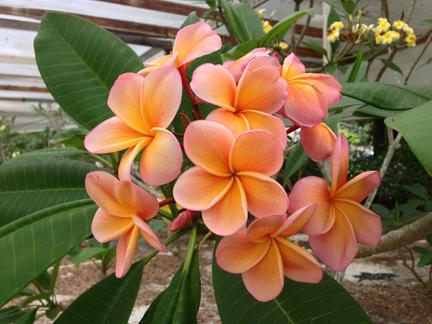
While the plants are fairly tolerant of both salt and windy conditions, they’re not tolerant of cold and must be protected. Therefore, they should be container grown in colder regions. In areas that may be warm most of the time but still fairly prone to cold winters, the plant can be dug up and overwintered indoors. Alternatively, you can sink container grown Plumerias in the ground, bringing them indoors once the temperatures begin to drop in fall. Once warmer temps return in spring, you can return the plants back outdoors.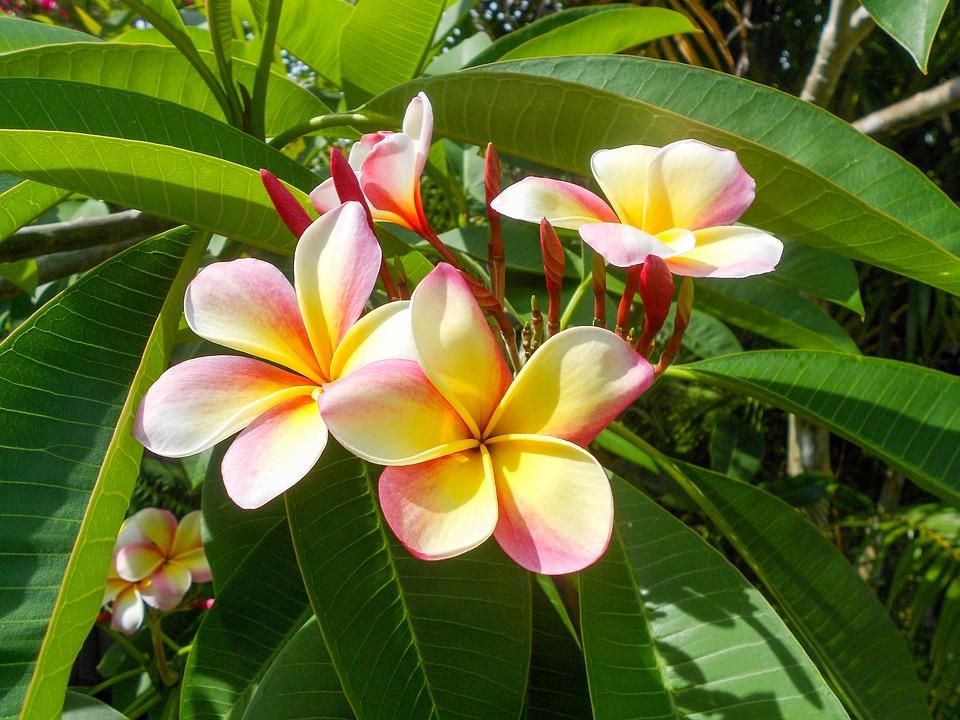
When growing Plumeria plants in pots, use a coarse, well-draining potting mix—cactus mix or perlite and sand should be fine.
Plumeria care, for the most part, is minimal. While Plumerias don’t like wet feet, they should be watered deeply when irrigated and then allowed to dry out some before watering again. They also need to be fertilized about every two to three weeks throughout their active growing season. Reduce watering in mid fall and stop completely once the plants enter dormancy in winter. Resume regular watering as new growth appears in spring. A high phosphate (phosphorus) fertilizer, like 10-30-10, will help encourage blooms. Giving them too much nitrogen will only result in more foliage growth and less flowering.
Pruning
Plumerias may be pruned as needed (up to 12 inches from ground) in late winter or early spring (prior to new growth); however, any drastic or hard pruning done may reduce flowering.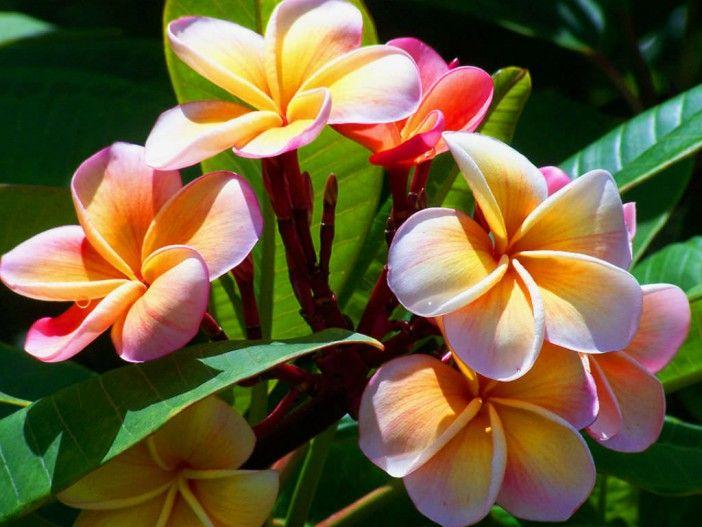
Propagation
These plants can also be propagated by seeds or cuttings in spring, with cuttings being the easiest and most preferred method. Insert cuttings about 2 inches in potting mix and water thoroughly.

Although you don’t have to live in the tropics to grow Plumeria in the home garden, you should be aware of its growing requirements beforehand.
Growing Conditions and General Care
Often grown in the garden as an ornamental shrub or small tree, Plumeria plants need to be grown in well-draining soil that is slightly acidic. They also need at least six hours of full sun.

While the plants are fairly tolerant of both salt and windy conditions, they’re not tolerant of cold and must be protected. Therefore, they should be container grown in colder regions. In areas that may be warm most of the time but still fairly prone to cold winters, the plant can be dug up and overwintered indoors. Alternatively, you can sink container grown Plumerias in the ground, bringing them indoors once the temperatures begin to drop in fall. Once warmer temps return in spring, you can return the plants back outdoors.

When growing Plumeria plants in pots, use a coarse, well-draining potting mix—cactus mix or perlite and sand should be fine.
Plumeria care, for the most part, is minimal. While Plumerias don’t like wet feet, they should be watered deeply when irrigated and then allowed to dry out some before watering again. They also need to be fertilized about every two to three weeks throughout their active growing season. Reduce watering in mid fall and stop completely once the plants enter dormancy in winter. Resume regular watering as new growth appears in spring. A high phosphate (phosphorus) fertilizer, like 10-30-10, will help encourage blooms. Giving them too much nitrogen will only result in more foliage growth and less flowering.

Pruning
Plumerias may be pruned as needed (up to 12 inches from ground) in late winter or early spring (prior to new growth); however, any drastic or hard pruning done may reduce flowering.

Propagation
These plants can also be propagated by seeds or cuttings in spring, with cuttings being the easiest and most preferred method. Insert cuttings about 2 inches in potting mix and water thoroughly.
0
0
文章
Dummer. ゛☀
2017年09月29日

Scientific Name
Plumeria rubra L.

Common Names
Frangipani, Red Paucipan, Red Jasmine, Red Frangipani, Common Frangipani, Temple Tree, Plumeria
Synonyms
Plumeria rubra f. rubra, Plumeria acuminata, Plumeria acutifolia, Plumeria angustifolia, Plumeria arborea, Plumeria arborescens, Plumeria aurantia, Plumeria aurantiaca, Plumeria bicolor, Plumeria blandfordiana, Plumeria carinata, Plumeria conspicua, Plumeria gouanii, Plumeria incarnata, Plumeria jamesonii, Plumeria kerrii, Plumeria kunthiana, Plumeria lambertiana, Plumeria loranthifolia, Plumeria lutea, Plumeria macrophylla, Plumeria megaphylla, Plumeria mexicana, Plumeria milleri, Plumeria mollis, Plumeria northiana, Plumeria purpurea, Plumeria tenuifolia, Plumeria tricolor
Scientific Classification
Family: Apocynaceae
Subfamily: Rauvolfioideae
Tribe: Plumerieae
Genus: Plumeria

Flower
Color: Pink, white and yellow
Bloom Time: Summer and autumn
Description
Plumeria rubra is a delightful small tree for a garden with a semi-tropical look. It grows as a spreading tree up to 26 feet (8 m) high and wide, and is flushed with fragrant flowers of shades of pink, white and yellow over the summer and autumn.
Hardiness
USDA hardiness zone 10a to 11b: from 30 °F (−1.1 °C) to 50 °F (+10 °C).

How to Grow and Care
Although you don’t have to live in the tropics to grow Plumeria in the home garden, you should be aware of its growing requirements beforehand.
Often grown in the garden as an ornamental shrub or small tree, Plumeria plants need to be grown in well-draining soil that is slightly acidic. They also need at least six hours of full sun.
While the plants are fairly tolerant of both salt and windy conditions, they’re not tolerant of cold and must be protected. Therefore, they should be container grown in colder regions. In areas that may be warm most of the time but still fairly prone to cold winters, the plant can be dug up and overwintered indoors. Alternatively, you can sink container grown Plumerias in the ground, bringing them indoors once the temperatures begin to drop in fall. Once warmer temps return in spring, you can return the plants back outdoors.
When growing Plumeria plants in pots, use a coarse, well-draining potting mix—cactus mix or perlite and sand should be fine.
Origin
Native to Mexico, Central America, Colombia and Venezuela.
Plumeria rubra L.

Common Names
Frangipani, Red Paucipan, Red Jasmine, Red Frangipani, Common Frangipani, Temple Tree, Plumeria
Synonyms
Plumeria rubra f. rubra, Plumeria acuminata, Plumeria acutifolia, Plumeria angustifolia, Plumeria arborea, Plumeria arborescens, Plumeria aurantia, Plumeria aurantiaca, Plumeria bicolor, Plumeria blandfordiana, Plumeria carinata, Plumeria conspicua, Plumeria gouanii, Plumeria incarnata, Plumeria jamesonii, Plumeria kerrii, Plumeria kunthiana, Plumeria lambertiana, Plumeria loranthifolia, Plumeria lutea, Plumeria macrophylla, Plumeria megaphylla, Plumeria mexicana, Plumeria milleri, Plumeria mollis, Plumeria northiana, Plumeria purpurea, Plumeria tenuifolia, Plumeria tricolor
Scientific Classification
Family: Apocynaceae
Subfamily: Rauvolfioideae
Tribe: Plumerieae
Genus: Plumeria

Flower
Color: Pink, white and yellow
Bloom Time: Summer and autumn
Description
Plumeria rubra is a delightful small tree for a garden with a semi-tropical look. It grows as a spreading tree up to 26 feet (8 m) high and wide, and is flushed with fragrant flowers of shades of pink, white and yellow over the summer and autumn.
Hardiness
USDA hardiness zone 10a to 11b: from 30 °F (−1.1 °C) to 50 °F (+10 °C).

How to Grow and Care
Although you don’t have to live in the tropics to grow Plumeria in the home garden, you should be aware of its growing requirements beforehand.
Often grown in the garden as an ornamental shrub or small tree, Plumeria plants need to be grown in well-draining soil that is slightly acidic. They also need at least six hours of full sun.
While the plants are fairly tolerant of both salt and windy conditions, they’re not tolerant of cold and must be protected. Therefore, they should be container grown in colder regions. In areas that may be warm most of the time but still fairly prone to cold winters, the plant can be dug up and overwintered indoors. Alternatively, you can sink container grown Plumerias in the ground, bringing them indoors once the temperatures begin to drop in fall. Once warmer temps return in spring, you can return the plants back outdoors.
When growing Plumeria plants in pots, use a coarse, well-draining potting mix—cactus mix or perlite and sand should be fine.
Origin
Native to Mexico, Central America, Colombia and Venezuela.
0
0
文章
Dummer. ゛☀
2017年09月29日

Scientific Name
Plumeria obtusa L.

Common Names
Singapore Graveyard Flower, Singapore Plumeria, Singapore Frangipani, Great Frangipanni, Chempaka, Lei Flower, White Plumeria
Synonyms
Plumeria barahonensis, Plumeria jamaicensis
Scientific Classification
Family: Apocynaceae
Subfamily: Rauvolfioideae
Tribe: Plumerieae
Genus: Plumeria

Flower
Color: White with small, brilliant yellow center
Bloom Time: May to October
Description
Plumeria obtusa (Singapore Graveyard Flower) is a small shrub or tree, up to 20 feet (6 m) with widely spaced thick succulent branches. The leaves are found in clusters near the tips of the branches. They are large, dark green, glossy, with obtuse tips. The flowers are fragrant, 5-petaled, and white with a small yellow center, borne in clusters at the ends of the branches on a long thick stalk.

How to Grow and Care
Although you don’t have to live in the tropics to grow Plumeria in the home garden, you should be aware of its growing requirements beforehand.
Often grown in the garden as an ornamental shrub or small tree, Plumeria plants need to be grown in well-draining soil that is slightly acidic. They also need at least six hours of full sun.
While the plants are fairly tolerant of both salt and windy conditions, they’re not tolerant of cold and must be protected. Therefore, they should be container grown in colder regions. In areas that may be warm most of the time but still fairly prone to cold winters, the plant can be dug up and overwintered indoors. Alternatively, you can sink container grown Plumerias in the ground, bringing them indoors once the temperatures begin to drop in fall. Once warmer temps return in spring, you can return the plants back outdoors.
When growing Plumeria plants in pots, use a coarse, well-draining potting mix—cactus mix or perlite and sand should be fine.
Origin
Native to the Bahamas and the Greater Antilles in Central America.
Plumeria obtusa L.

Common Names
Singapore Graveyard Flower, Singapore Plumeria, Singapore Frangipani, Great Frangipanni, Chempaka, Lei Flower, White Plumeria
Synonyms
Plumeria barahonensis, Plumeria jamaicensis
Scientific Classification
Family: Apocynaceae
Subfamily: Rauvolfioideae
Tribe: Plumerieae
Genus: Plumeria

Flower
Color: White with small, brilliant yellow center
Bloom Time: May to October
Description
Plumeria obtusa (Singapore Graveyard Flower) is a small shrub or tree, up to 20 feet (6 m) with widely spaced thick succulent branches. The leaves are found in clusters near the tips of the branches. They are large, dark green, glossy, with obtuse tips. The flowers are fragrant, 5-petaled, and white with a small yellow center, borne in clusters at the ends of the branches on a long thick stalk.

How to Grow and Care
Although you don’t have to live in the tropics to grow Plumeria in the home garden, you should be aware of its growing requirements beforehand.
Often grown in the garden as an ornamental shrub or small tree, Plumeria plants need to be grown in well-draining soil that is slightly acidic. They also need at least six hours of full sun.
While the plants are fairly tolerant of both salt and windy conditions, they’re not tolerant of cold and must be protected. Therefore, they should be container grown in colder regions. In areas that may be warm most of the time but still fairly prone to cold winters, the plant can be dug up and overwintered indoors. Alternatively, you can sink container grown Plumerias in the ground, bringing them indoors once the temperatures begin to drop in fall. Once warmer temps return in spring, you can return the plants back outdoors.
When growing Plumeria plants in pots, use a coarse, well-draining potting mix—cactus mix or perlite and sand should be fine.
Origin
Native to the Bahamas and the Greater Antilles in Central America.
0
0
成长记
Plants Encyclopdias
2016年08月17日
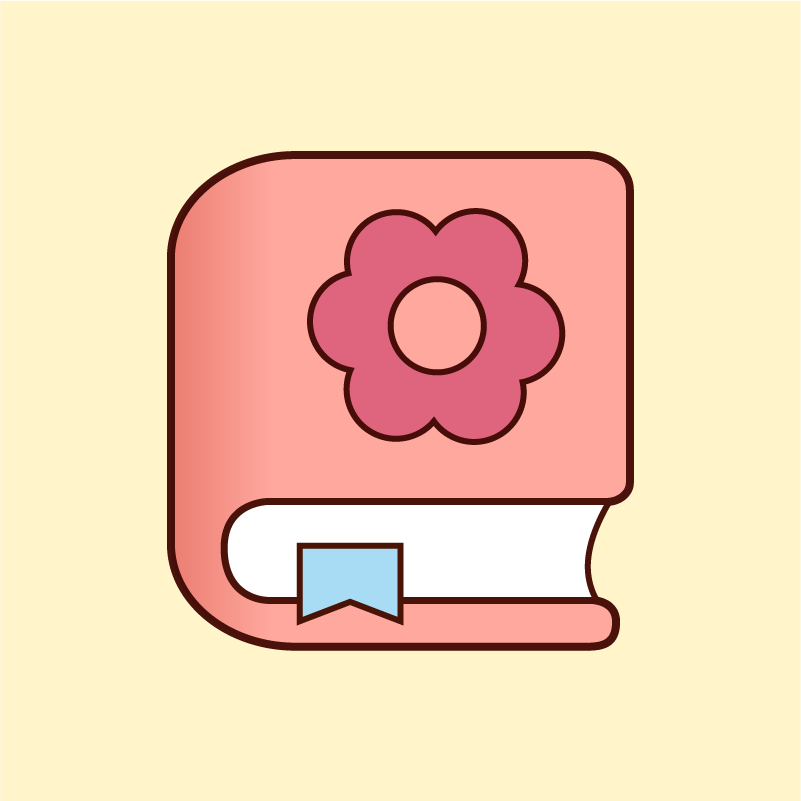
Name: Frangipani
Latin: Plumeria
Origin: South America
Plant height: 100 - 300 cm
Reproduction: #Layering
Difficulty level: #Medium
Tags: #SouthAmerica #Plumeria

Latin: Plumeria
Origin: South America
Plant height: 100 - 300 cm
Reproduction: #Layering
Difficulty level: #Medium
Tags: #SouthAmerica #Plumeria

2
3
Nrags22:From Ann O'D 2016. Repotted after garage game for winter. One from Andie rooting 4/8/2017 for Peggy.



